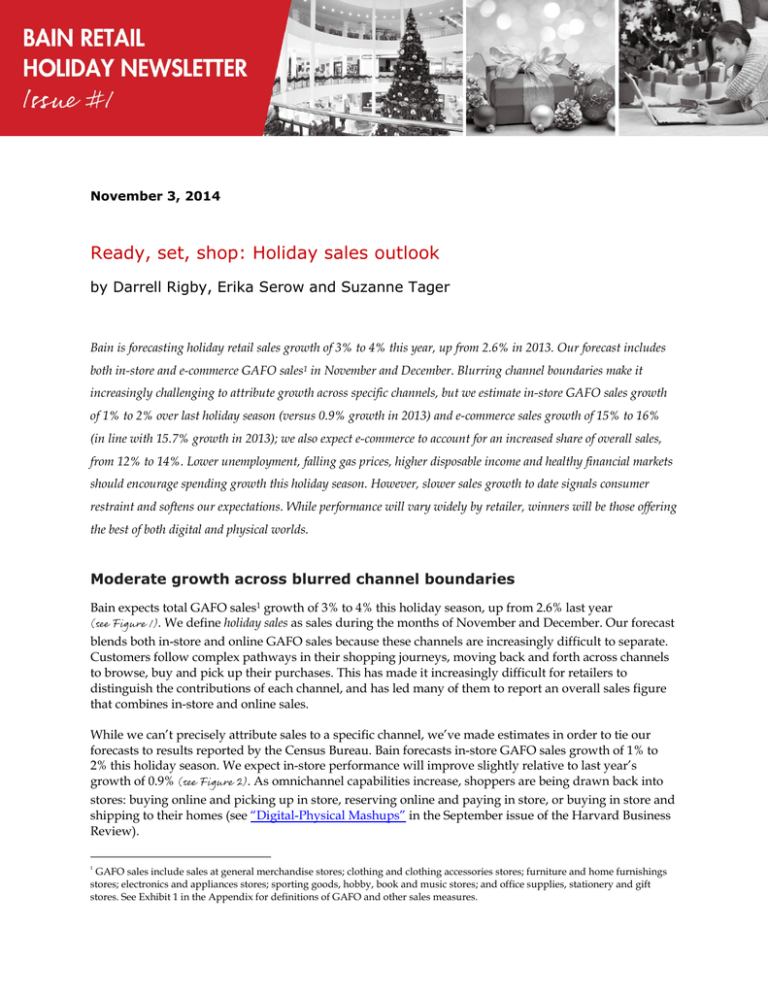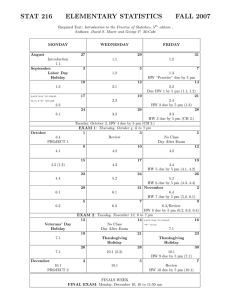Ready, set, shop: Holiday sales outlook
advertisement

November 3, 2014 Ready, set, shop: Holiday sales outlook by Darrell Rigby, Erika Serow and Suzanne Tager Bain is forecasting holiday retail sales growth of 3% to 4% this year, up from 2.6% in 2013. Our forecast includes both in-store and e-commerce GAFO sales1 in November and December. Blurring channel boundaries make it increasingly challenging to attribute growth across specific channels, but we estimate in-store GAFO sales growth of 1% to 2% over last holiday season (versus 0.9% growth in 2013) and e-commerce sales growth of 15% to 16% (in line with 15.7% growth in 2013); we also expect e-commerce to account for an increased share of overall sales, from 12% to 14%. Lower unemployment, falling gas prices, higher disposable income and healthy financial markets should encourage spending growth this holiday season. However, slower sales growth to date signals consumer restraint and softens our expectations. While performance will vary widely by retailer, winners will be those offering the best of both digital and physical worlds. Moderate growth across blurred channel boundaries Bain expects total GAFO sales1 growth of 3% to 4% this holiday season, up from 2.6% last year (see Figure 1). We define holiday sales as sales during the months of November and December. Our forecast blends both in-store and online GAFO sales because these channels are increasingly difficult to separate. Customers follow complex pathways in their shopping journeys, moving back and forth across channels to browse, buy and pick up their purchases. This has made it increasingly difficult for retailers to distinguish the contributions of each channel, and has led many of them to report an overall sales figure that combines in-store and online sales. While we can’t precisely attribute sales to a specific channel, we’ve made estimates in order to tie our forecasts to results reported by the Census Bureau. Bain forecasts in-store GAFO sales growth of 1% to 2% this holiday season. We expect in-store performance will improve slightly relative to last year’s growth of 0.9% (see Figure 2). As omnichannel capabilities increase, shoppers are being drawn back into stores: buying online and picking up in store, reserving online and paying in store, or buying in store and shipping to their homes (see “Digital-Physical Mashups” in the September issue of the Harvard Business Review). 1 GAFO sales include sales at general merchandise stores; clothing and clothing accessories stores; furniture and home furnishings stores; electronics and appliances stores; sporting goods, hobby, book and music stores; and office supplies, stationery and gift stores. See Exhibit 1 in the Appendix for definitions of GAFO and other sales measures. Our forecast for e-commerce growth of 15% to 16% is in line with last year and reflects the momentum we’ve seen in online sales during the first half of this year (see Figure 3). Mobile commerce, which accounts for 11% of e-commerce, is contributing to this momentum with second-quarter growth of 47% over last year. We expect e-commerce to account for an increased share of overall GAFO sales, growing from 12% to 14%. Economic indicators suggest that holiday spend will increase this year. Lower levels of unemployment and increased disposable income will benefit lower income households. Meanwhile, the continued increase in stock market values will bolster spending by upper income households over the holidays. However, slower sales momentum this year softens our expectations. Lower growth in year-to-date and back-to-school spending this year compared to last year signals consumer restraint (see Figure 4). Figure 1: Growth in holiday omnichannel GAFO sales, 2001–2014F Note: Holiday is defined as November and December; growth rates are based on the most comparable data available by time; growth rates for 2014 are Bain’s forecast. Sources: US Census Bureau; Forrester Research; Bain analysis 2014 Retail Holiday Newsletter #1 | Page 2 Figure 2: Growth in holiday in-store GAFO sales, 1980–2014F 30-year avg. = 4.3% 20-year avg. = 3.2% 10-year avg. = 1.9% Recession years: Jul 81– Nov 82 Jan 90– Mar 91 Mar 01– Nov 01 Dec 07– Jun 09 Note: Holiday is defined as November and December; growth rates are based on the most comparable data available by time; growth rates for 2014 are Bain’s forecast. Sources: US Census Bureau; Forrester Research; Bain analysis Figure 3: E-commerce year-over-year quarterly sales growth, 2009–2014F Note: Growth rates for the third and fourth quarters of 2014 are Bain’s estimate and forecast, respectively; the third-quarter 2014 estimate is based on the projected growth of 15.5% year over year, actual first- and second-quarter 2014 results, and Bain’s fourth-quarter 2014 forecast. Sources: US Census Bureau; comScore; Bain analysis 2014 Retail Holiday Newsletter #1 | Page 3 Figure 4: Indicators of holiday GAFO sales growth Note: Items tested that showed no significant relationship (p > 0.2) to GAFO growth: gas prices, CPI, household debt, existinghome sales, US dollar index, 10-year T-note rate; headline unemployment had similar results to unemployment inclusive of underemployment or discouraged; bps stands for basis points; for top 30 retailers with international divisions, US-only Q4 growth rate was derived using the ratio of US growth to international growth for the year to date; shortest period for indicator significance analysis is 2003-2014 (longest period used is 1993-2014). Sources: US Department of Treasury; US Census Bureau; Bureau of Labor Statistics; Capital IQ; Thomson Reuters/University of Michigan Economic conditions vary by household segment Current economic conditions impact different segments of the population in different ways. Our analysis suggests that the economic indicators most closely correlated to holiday spending will mildly benefit the 50% of households earning less than $50,000 a year. With lower unemployment and higher levels of disposable income, these lower income households are on slightly better financial footing than they were a year ago, and have more savings and credit to draw on for holiday spending. In addition, higher income households earning $100,000-plus a year will benefit from continued growth in financial markets. Lower unemployment levels. “Headline unemployment”—the rate of unemployment based on the number of people who officially say they don’t have a job and are looking for work—is down by 130 basis points since this time last year, dropping from 7.2% to 5.9%, the lowest level since 2008. More important, the sum of unemployment, underemployment and discouraged workers is down by a total of 190 basis points, from 13.6% to 11.8%, suggesting an even greater impact on consumers’ confidence and ability to spend this holiday season (see Figure 5). Combined with a slight increase in nominal wage rates of 2% over last year, we should see a 4.6% increase in wage income, or an additional $4.3 billion in average weekly wages. 2014 Retail Holiday Newsletter #1 | Page 4 Falling gas prices. At $3 a gallon, the average price of gas is the lowest it’s been over the last three and a half years and is 8% lower than it was a year ago. Prices have dropped 14% since the beginning of August. Lower gas prices mean consumers will have more dollars to spend going into the holidays. Although these savings may not have a significant impact on spending behavior in upper- and middle-income households, most lower-income households will feel the difference, with savings on gas representing 10% of their average holiday spending. Higher disposable income, savings rate and credit levels. Disposable income has increased 2.5% in real terms over last year, boosting consumer optimism. The Consumer Confidence Index and the Michigan Consumer Sentiment Index are up by 19% and 7% respectively this year, with strong momentum since July (5% and 6% growth respectively). And households are saving more, with savings growing year-over-year after declining in 2013. With greater confidence, consumers are willing to take on slightly more debt: Overall credit levels have increased 3.1%, or $26 billion, since this time last year due to rising revolving-credit levels, primarily in credit cards. Continued growth in financial markets. Despite recent volatility, the S&P 500 index is up 10% to date this year and has reached an all-time high. This continued upward trajectory bodes well for upper-income households earning $100,000-plus a year as two-thirds of their wealth is held in financial assets. These households make up only about one fifth of US households but account for over a third of total US consumer spending and have historically contributed a disproportionate share to holiday spending. Bain’s global luxury goods study, published in October, expects the personal luxury market to grow 5% in the United States in 2014.2 Figure 5: Measures of unemployment, September 2007–September 2014 Note: YOY stands for year over year; data are seasonally adjusted; bps stands for basis points. Source: Bureau of Labor Statistics 2 For a copy of Bain’s “Global Luxury Goods Worldwide Market Study, Fall 2014 Update,” please contact Dan Pinkney at dan.pinkney@bain.com. 2014 Retail Holiday Newsletter #1 | Page 5 Slower sales momentum softens expectations Year-to-date and back-to-school sales performance, strong predictors of holiday GAFO sales, have both seen slower growth as consumers shift their spending to new cars, health and personal care, and building materials. This slower momentum in GAFO sales signals consumer restraint heading into the holidays and softens our expectations. Slower sales growth to date. Both year-to-date and back-to-school sales growth are strong predictors of holiday sales, with a combined R-squared of 0.47. This year, in-store GAFO sales increased just 1.0% year over year from January to September, and back-to-school sales grew 2.2% for the months of July and August. Although these rates are only slightly under last year’s (see Figure 6), they are appreciably below growth rates in 2012 of 4.1% and 3.2% respectively. Continued shift in spend to non-GAFO categories. Consumers have shifted their spending away from GAFO categories toward durables and consumables. Consumer spending on motor vehicles between January and September increased 8.1%, a function of easy credit and an aging fleet. Health and personal care also experienced significant growth of 6.0% during this period, while building and gardening grew 4.5%, reflecting sustained growth in sales of new homes. Figure 6: Year-over-year in-store GAFO sales growth by month, 2013 and 2014 10 year avg. = 2.9% Note: Excludes e-commerce; not seasonally adjusted; includes furniture and home furnishings, electronics and appliances, clothing, sporting goods, books, music, hobby, general merchandise, office supplies, stationery and gifts; September 2014 is an advance estimate of GAFS. Source: US Census Bureau Retailers are gearing up for the holidays With the stretch between Thanksgiving and Christmas being short again this year (five days shorter than it was in 2012), more and more retailers are starting the season early. Walmart, Toys “R” Us and Target revealed their holiday top toys in September; holiday displays have been popping up in store windows across the nation; and the season’s first promotions have long been announced. There are a number of reasons retailers want to extend the holiday season. First, a longer season means less chaos in stores, which means a more-productive shopping environment, and that means higher sales. 2014 Retail Holiday Newsletter #1 | Page 6 A longer season also gives retailers a chance to restock merchandise and eases the need for extra distribution capacity. It reduces overtime costs, too, as well as the need to recruit, train, supervise and then dismiss large numbers of temporary workers and extra security personnel. Finally, it lessens the risk of bad weather keeping last-minute shoppers away from stores or delaying deliveries to their homes. And survey data seem to support the idea that a longer holiday season is a better one. According to the National Retail Federation, 20% of consumers started their holiday buying in September, and 40% were shopping by Halloween. We conducted our own study with PollBuzzer in September and surveyed 550 adults in the United States.3 When asked how they felt about retailers putting up holiday displays this early, one-third claimed that early launches drive them crazy, one-third was largely indifferent or found the displays “a little” annoying, but a surprising one-third said they liked or even loved early holiday promotions (see Figure 7). The positive responders report that early holiday marketing puts them in a good mood, keeps them from procrastinating and gives them helpful ideas. Those most likely to appreciate early promotions include shoppers under 45, those with children in their households and those with annual incomes under $20,000. This last group may welcome the chance to spread holiday spending over a longer period. Figure 7: PollBuzzer survey: How do you feel about retailers putting up holiday displays in September? N= 621 Source: Bain online survey of consumers via PollBuzzer, September 17-18 2014 3 PollBuzzer™ (www.AskPollBuzzer.com) offers a real-time consumer opinion survey product. According to PollBuzzer, clients use demographic, geographic and socioeconomic filters to build customized panels drawn from PollBuzzer’s proprietary national respondent pool, build their own surveys using a do-it-yourself Web interface and receive Excel-formatted results in as little as one hour after launch. 2014 Retail Holiday Newsletter #1 | Page 7 Amazon may be showing signs of weakness, but it’s bigger than ever this holiday season E-commerce is front and center this holiday season, and we’ll be watching closely to see what Amazon has in store. The company’s recent earnings announcement disappointed investors in both revenues and profits. Although Amazon continued to show growth in North America in the third quarter, rising costs resulted in a razor-thin operating margin of 0.7% (versus 4% in 2009). Low levels of investor confidence have led to a 25% decline in the company’s market capitalization year to date, falling from $182 billion to $137 billion. Yet the online retail giant, which accounts for more than 20% of US online retail sales by gross merchandise value, continues to outpace US e-commerce growth year over year. It has continued to solidify its leadership through broad assortments, low prices and quick delivery. Expanding its product range by about 10% this year to offer more than 250 million SKUs, it stocks 2,000 times as much as an average superstore. In a single month, Amazon has up to 120,000 unique visitors, three to five times what the largest US retailers see. It continues to raise expectations for rapid fulfillment: It currently offers sameday delivery in 12 cities and plans to offer Sunday delivery to 50% of the nation’s population by the end of the year. With more than 50 distribution centers in the United States, 8 new “sortation centers” (which send packages to nearby post offices), expansion of Amazon Lockers into new markets and the trial of its own delivery network in select urban centers, Amazon continues to set the bar for what it takes to win the last mile. Heading into a season of heavy promotions and last-minute deliveries, we expect to see Amazon use its scale to win pricing and distribution battles throughout the holidays. And this year the online giant is hoping to counter the one advantage traditional retailers have over online pure plays: stores. Amazon will be operating two pop-up stores in California during the holiday season and is rumored to be opening its first permanent physical store in the middle of New York City. This permanent space would allow customers to browse the company’s latest technology products and give them the added convenience of picking up or returning items in store. Looking forward: Drivers of success this holiday season Although there is potential for growth this holiday season, as reflected in our forecast of 3% to 4% omnichannel GAFO growth, there will be winners and losers across categories. Retailers that come up with new ways to offer the best of both physical and digital worlds will come out on top. New technologies are improving in-store shopping experiences, reducing checkout times, customizing offers, enabling safe mobile payments and more. Improved fulfillment capabilities and innovative third-party players are helping retailers compete in the last mile. And, as every year, we expect heated pricing battles. This should be a very exciting holiday season to watch. We look forward to discussing these themes and sharing insights on what winners are doing this holiday season in the upcoming editions of our Retail Holiday Newsletter: Issue #2 (mid-November): Spotlight on technology. Issue #3 (early December): All eyes on shipping as retailers sprint toward Christmas. Issue #4 (mid-December): The art and science of pricing. Issue #5 (late January): Post-holiday outlook. Please let us know if you have specific topics you would like to learn more about. We look forward to sharing news of innovations and interesting strategies with you this holiday season. 2014 Retail Holiday Newsletter #1 | Page 8 Digital-physical mashups By Darrell K. Rigby Most companies are still in the early stages of a "digical" transformation, wrestling with how to make fusion strategies work. Drawing on our study of leaders from 20 global industries, we have identified five rules that account for much of the difference between success and failure. (Harvard Business Review) READ MORE > Appendix Exhibit 1: Definitions of retail sales measures ` O mnichannel GAFO Traditional in-store GAFO GAFS GAF General merchandise stores Clothing and clothing accessories stores Furniture and home furnishings stores Electronics and appliances stores Sporting goods, hobby, book and music stores Office supplies, stationery and gift stores Online sales in the categories above All other retail trade sales not included in GAFO Note: Omnichannel GAFO sales include in-store and online sales for both traditional retailers and online-only retailers. In-store GAFO sales do not include sales of online-only retailers or the online sales of omnichannel retailers that break out online sales in their reporting. However, in-store GAFO sales may include the online sales of omnichannel retailers that do not distinguish between their online and offline sales in their census filings. 2014 Retail Holiday Newsletter #1 | Page 9 Selected references Bain & Company has included in this document information and analyses based on the sources referenced below as well as our own research and experience. Bain has not independently verified this information and makes no representation or warranty, express or implied, that such information is accurate or complete. Projected market and financial information, analyses and conclusions contained herein are based (unless sourced otherwise) on the information described above, and Bain’s judgments should not be construed as definitive forecasts or guarantees of future performance or results. Neither Bain & Company nor any of its subsidiaries or their respective officers, directors, shareholders, employees or agents accept any responsibility or liability with respect to this document. AAA. “Gasoline Closes in on $3 Per Gallon.” AAA NewsRoom (http://fuelgaugereport.aaa.com/gasoline-closes-in-on-3-per-gallon), October 27, 2014. Accenture. The Secrets of Seamless Retailing Success. http://www.accenture.com/SiteCollectionDocuments/ PDF/Accenture-The-Secrets-of-Seamless-Retailing-Success.pdf, May 2014. AlixPartners. “August: Holiday 2014: Play It Again, Sam.” September Retail Viewpoint (http://www.alixpartners.com/en/Publications/AllArticles/tabid/635/articleType/ArticleView/article Id/1387/ August-Holiday-2014-Play-It-Again-Sam.aspx), September 2014. Amazon.com. “About Amazon Media Group.” http://www.amazon.com/b?ie=UTF8&node=8445211011 (accessed October 16, 2014). Bensinger, Greg, and Keiko Morris. “Amazon to Open First Brick-and-Mortar Site.” WSJ.com, October 9, 2014. Bensinger, Greg, and Laura Stevens. “Amazon, in Threat to UPS, Tries Its Own Deliveries.” WSJ.com, April 24, 2014. Bureau of Labor Statistics. “Unemployment Rate (Seasonally Adjusted).” Table (http://data.bls.gov/cgibin/surveymost?bls) (accessed October 3, 2014). Capital IQ. Historical stock price data and consensus estimates. October 29, 2014. Christensen, Doreen. “Christmas in October? Bah Humbug!” Sun-Sentinel.com, October 19, 2014. Consumer Electronics Association. “CEA’s 21st Annual Holiday Outlook.” Slide presentation. Available at http://www.ce.org/holiday (accessed October 30, 2014). D’Arpizio, Claudia. Altagamma 2014 Worldwide Markets Monitor. Milan: Bain & Company and Fondazione Altagamma, October 14, 2014. Davis, Don. “Walmart.com Ups Its Game.” Internet Retailer (http://www.internetretailer.com/ 2013/10/15/walmartcom-ups-its-game), October 15, 2013. Deloitte. “Deloitte Forecast: Retail Holiday Sales to Increase 4 to 4.5 Percent.” Press release (http://www.deloitte.com/view/en_US/us/press/Press-Releases/ febf17add2e88410VgnVCM2000003356f70aRCRD.htm), September 24, 2014. 2014 Retail Holiday Newsletter #1 | Page 10 Deloitte. Fifth Annual eCommerce Assessment. http://www.deloitte.com/assets/Dcom-UnitedStates/ Local%20Assets/Documents/us_Retail_FifthAnnualeCommerceAssessment_040714.pdf, September 2014. Enright, Allison. “U.S. Online Retail Sales Will Grow 57% by 2018.” Internet Retailer (http://www.internetretailer.com/2014/05/12/us-online-retail-sales-will-grow-57-2018), May 12, 2014. Federal Reserve Bank of St. Louis. “Real Disposable Personal Income: Per Capita.” Graph (http://research.stlouisfed.org/fred2/graph/?id=A229RX0), October 31, 2014. Federal Reserve Board. “Household Debt Service and Financial Obligations Ratios.” Table (http://www.federalreserve.gov/releases/housedebt/), October 7, 2014. Fulgoni, Gian. “State of the U.S. Online Retail Economy.” comScore presentation (https://www.comscore.com/Insights/Presentations-and-Whitepapers/2014/State-of-the-US-OnlineRetail-Economy-in-Q2-2014), September 17, 2014. Accessed October 9, 2014. Grey, Paul. “How Many (More) Products Does Amazon Sell?” ExportX (http://exportx.com/2014/08/14/ many-products-amazon-sell-2/), August 14, 2014. Halzack, Sarah. “Is the New Technology at Macy’s Our First Glimpse of the Future of Retail?” WashingtonPost.com (http://www.washingtonpost.com/news/business/wp/2014/09/25/is-the-new -technology-at-macys-our-first-glimpse-of-the-future-of-retail/?tid=hpModule_79c38dfc-8691-11e2-9d71 -f0feafdd1394), September 25, 2014. Halzack, Sarah. “Will This Holiday Season Be the Shot in the Arm That Retailers Need?” WashingtonPost.com (http://www.washingtonpost.com/business/economy/will-this-holiday-seasonbe-the-shot-in-the-arm-that -retailers-need/2014/10/06/ba8d0338-4d7b-11e4-aa5e-7153e466a02d_story.html), October 7, 2014. International Council of Shopping Centers. “ICSC Forecasts U.S. Holiday Sales to Increase by 4.0%.” Press release (http://www.icsc.org/press/icsc-forecasts-u.s.-holiday-sales-to-increase-by-4.0), October 14, 2014. Internet Retailer. “Amazon Grows Faster Than U.S. e-Commerce.” Table (http://www.internetretailer.com/ trends/e-retailers/amazon-grows-faster-us-e-commerce/) (accessed October 27, 2014). Kell, John. “Amazon Dips Its Toes into Brick-and-Mortar Retailing.” Fortune.com (http://fortune.com/2014/ 10/14/amazon-pop-up-kiosks/), October 14, 2014. Lipsman, Andrew. “Q2 m-Commerce Explodes to 47% Y/Y Gain: What It Means for the Growth of Mobile.” Insights/Blog (http://www.comscore.com/Insights/Blog/Q2-M-Commerce-Explodes-to-47-YYGain-What-it -Means-for-the-Growth-of-Mobile), August 19, 2014. Love, Jon. “Amazon’s International Growth Slows.” Internet Retailer (http://www.internetretailer.com/2014/ 02/13/amazons-international-growth-slows), February 13, 2014. 2014 Retail Holiday Newsletter #1 | Page 11 Low, Elaine. “Macy’s Same-Day Delivery Steps Up Game Vs. Amazon.” Investors.com (http://news.investors .com/business/091514-717377-macys-same-day-delivery-vs-amazon.htm), September 15, 2014. Madia, Manini J., and Mark Matiszik. “Defining the Value of Omnichannel Shopping.” The Robin Report (http://therobinreport.com/defining-the-value-of-omnichannel-shopping/?utm_source=The+Robin +Report&utm_campaign=6f8a61fe2c-Defining_the_Value_of_Omnichannel_10_20_2014&utm _medium=email&utm_term=0_e90268c709-6f8a61fe2c-212562457), October 20, 2014. Mahaney, Mark, Rohit Kulkarni, Brian Peak and Andrew Bruckner. Amazon.com: Updating the Long Thesis. RBC Capital Markets, September 18, 2014. MWPVL International. “Amazon Global Fulfillment Center Network.” http://www.mwpvl.com/html/amazon _com.html, October 2014. National Association of Home Builders. “New Single-Family Home Sales.” Graph (http://www.nahb.org/ generic.aspx?sectionID=130&genericContentID=97096), October 24, 2014. National Retail Federation. Holiday Survival Kit 2014. https://nrf.com/resources/retail-library/holidaysurvival -kit-2014, October 7, 2014. National Retail Federation. “Optimism Shines as National Retail Federation Forecasts Holiday Sales to Increase 4.1%.” Press release (https://nrf.com/media/press-releases/optimism-shines-national-retail -federation-forecasts-holiday-sales-increase-41), October 7, 2014. Podsada, Janice. “No End in Sight to Cabela’s Expansion Plans.” Omaha.com (http://www.omaha.com/ money/no-end-in-sight-to-cabela-s-expansion-plans/article_37abfa9d-9954-505a-a23f-f22ffa3e3907.html), March 26, 2014. PwC. Achieving Total Retail: Consumer Expectations Driving the Next Retail Business Model. February 2014. Available at http://www.pwc.com/gx/en/retail-consumer/retail-consumer-publications/globalmulti-channel -consumer-survey/download.jhtml (accessed October 29, 2014). Rigby, Darrell K. “Digital-Physical Mashups.” Harvard Business Review, September 2014. Rupp, Lindsey. “U.S. Holiday Sales Seen Rising 4.1% on Employment Gains.” Bloomberg (http://www.bloomberg.com/news/2014-10-07/u-s-holiday-sales-seen-rising-4-1-on-employmentgains.html), October 7, 2014. “S&P/Case-Shiller 20-City Composite Home Price Index.” Graph (http://us.spindices.com/indices/real -estate/sp-case-shiller-20-city-composite-home-price-index), October 31, 2014. Sehgal, Vikram. Forrester Research Online Retail Forecast, 2013 to 2018 (US). March 21, 2014. Skyline Views. “Restoration Hardware to Open Flagship Buckhead Store This Fall; Now Hiring.” http://skylineviews.typepad.com/skyline_views/2014/07/restoration-hardware-ceo-tours-buckhead -construction-site-calls-new-location-chains-most-revolutiona.html, October 2, 2014. 2014 Retail Holiday Newsletter #1 | Page 12 Target. “Target Redefines Top Holiday Kids’ Gifts List and Introduces a Gift Detective to Make List Building More Fun.” Press release (http://pressroom.target.com/news/target-redefines-top-holidaykids-gifts-list-and -introduces-a-gift-detective-to-make-list-building-more-fun), October 21, 2013. Target. “Target Reveals Top Toys for the Upcoming Holidays and Announces New Assortment of Boutique Brand Toys.” Press release (http://pressroom.target.com/news/target-reveals-top-toys-for-theupcoming -holidays-and-announces-new-assortment-of-boutique-brand-toys), September 16, 2014. The Conference Board. “The Conference Board Consumer Confidence Index Declines.” Press release (https://www.conference-board.org/press/pressdetail.cfm?pressid=5289), September 30, 2014. Thompson Reuters/University of Michigan. “The Index of Consumer Sentiment.” Table (http://www.sca.isr.umich.edu/data-archive/mine.php) (accessed October 31, 2014). Trainer, David. “Three Reasons Why Amazon’s Cash Flow Is No Comfort.” Forbes (http://www.forbes.com/ sites/greatspeculations/2014/10/20/three-reasons-why-amazons-cash-flow-is-a-trap/), October 20, 2014. Toys “R” Us. “Toys ‘R’ Us Unveils the 2014 #truhottoylist.” Press release (http://www.toysrusinc.com/press -room/releases/general/2014/toysrus-unveils-the-2014-truhottoylist/), September 16, 2014. Tuttle, Brad. “Kmart Unleashes Season’s First Christmas Ad.” Money.com (http://time.com/money/3273765/ kmart-christmas-ad-layaway/), September 5, 2014. US Census Bureau. “Advance Monthly Sales for Retail and Food Services, September 2014.” News release (http://www.census.gov/retail/marts/www/marts_current.pdf), October 15, 2014. US Census Bureau. “Monthly Retail Trade Report, 1992–Present.” Table (http://www.census.gov/retail), October 15, 2014. US Department of the Treasury. “Daily Treasury Bill Rates Data.” Table (http://www.treasury.gov/resource -center/data-chart-center/interest-rates/Pages/TextView.aspx?data=billrates), October 14, 2014. US Energy Information Administration. “U.S. Regular Gasoline Prices.” Table (http://www.eia.gov/petroleum/ gasdiesel/), October 27, 2014. Verde Group and Baker Retailing Center. Understanding the Multi-Channel Shopper. April 2012. Available at http://www.wharton.upenn.edu/bakerretail/files/multichannel_shopping_exec_summary_Apr_2012.pdf (accessed October 29, 2014). Wahba, Phil. “Amazon Ranks Among Retail’s 10 Biggest Companies for the First Time.” Fortune.com (http://fortune.com/2014/07/01/10-largest-retailers-amazon/), July 1, 2014 2014 Retail Holiday Newsletter #1 | Page 13 Walmart. “Walmart Announces Plans for Black Friday 2013.” Press release (http://news.walmart.com/news -archive/2013/11/12/walmart-announces-plans-for-black-friday-2013), November 12, 2013. Walmart. “Walmart Unveils Its 2013 Top Toy List Chosen by Kids.” Press release (http://news.walmart.com/ news-archive/2013/09/12/walmart-unveils-its-2013-holiday-top-toy-list-chosen-by-kids), September 12, 2013. Walmart. “Walmart’s Kid-Approved 2014 Holiday Toy List Reveals New Trends.” Press release (http://news.walmart.com/news-archive/2014/09/10/walmarts-kid-approved-2014-holiday-toy-listreveals -new-trends), September 10, 2014. Wurmser, Yory. “Holiday Shopping 2014: Online Trends and Forecast.” eMarketer Webinar (http://www.emarketer.com/Webinar/Holiday-Shopping-2014Online-Trends-Forecast/4000091), September 18, 2014. Yahoo! Finance. “S&P 500: Historical Prices.” Table (https://finance.yahoo.com/q/hp?s=%5EGSPC +Historical+Prices) (accessed October 31, 2014). 2014 Retail Holiday Newsletter #1 | Page 14




